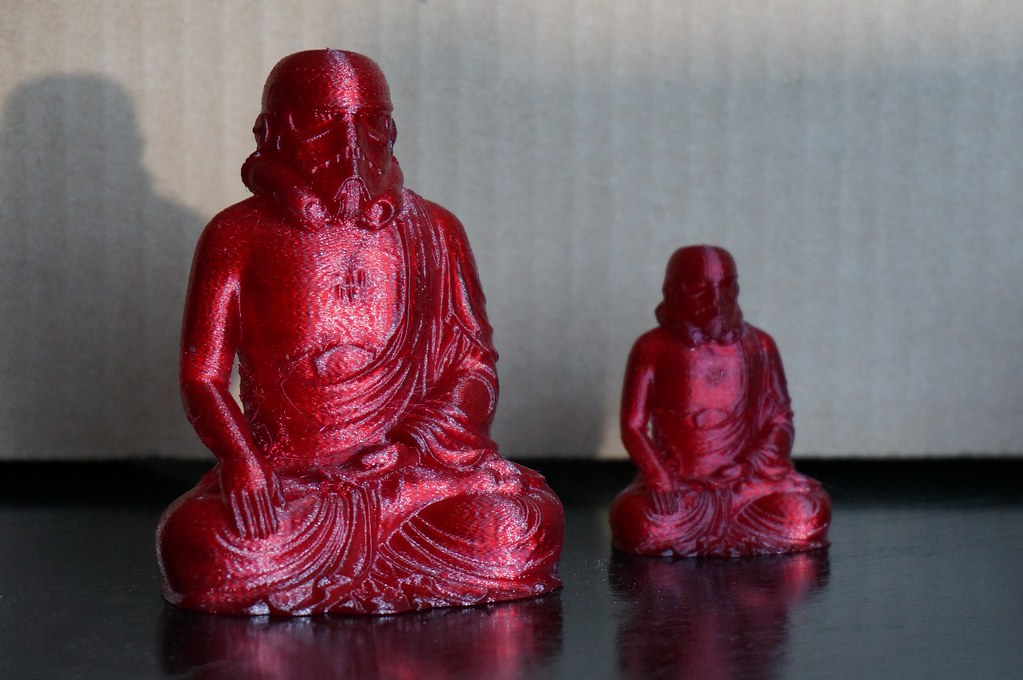Please be a dildo…please be a dildo…please be a dildo.
Click.
Damn.
Not a lot of info here, but this looks great:
I have an old Ultimaker. My nephew says that the newer Ultimaker 2 that his office got is very nice. It does ABS. Mine only handles PLA. I loaned mine to my brother for a few months; he got the thing working way better.
I have no idea how well those weird hexapod-type printers work.
I really want to build one just because they look cool. I printed some parts for one, and the guy who built it pretty much said he went with that model for the same reason. I think the general conscensus is that that the bowden extruder removes much of the mass from the print head, so it can print at faster speeds. I’m still kind of scared by the non-cartesianness of it though.
Do you have a link to what you mean by hexapod-type printer?
Google just gives me pictures of 3d-printed six legged robots.
Uhhh, that is pretty dang SWEET. How much did the foot control bracket cost to have shapeways do it? I am considering it for some other stuff and was just curious. Thanks!
google Kossel and mini Kossel. I’m building a mini kossel from a kit.
Aren’t they just standard end caps for box sections?
It’s essentially this:
It was expensive… The steel process isn’t cheap, and I probably made this a bit beefier than it needed to be. The stainless steel prints are very strong but I didn’t want to take any chances with such a critical part.
They charge by volume printed:
Upload your model and you will know right away how much it would cost to produce. The added cost to the final product is in printing plastic prototypes beforehand. Which is why I’d like to get my own printer, to offset the developments costs…
I got that, but what was your ballpark figure for the bracket? Just ballpark. Was this a $250 job or a $2500 job?
We need affordable steel printers…
What about simulation of parts, and perhaps even iterative way to remove material where not loaded and move it where it is needed more, a simulated way of how bones strengthen under load?
This is fantastic, Seyo!
My prints of the last 24 hours:


That would probably get ya jailed in Myanmar.
Thanks Mark! Next up will be a new LED tail light and turn signal cluster…
I’d love one, but it will be really, really hard to make one using known printing processes. DMLS and EBM use multi-hundred-watt lasers in inert atmosphere, or multi-kW electron beams under vacuum. The systems weigh over a ton and need 5 kW-20kW power supply. Can costs come down? Yeah. But will they get below $5k any time soon? No. Are they something you’d want in a home, office, or personal workshop? Not for most of us.
Simulation is a problem, and there are companies working on different parts of it, but they are aimed at industrial users and high-performance materials. See http://www.stratonics.com/, http://www.arevolabs.com/.
I’d say it’d be merely hard.
CO2 is an easy semi-inert atmosphere. Argon is better but somewhat more expensive. Lousy vacuum is easy (where the air conditioning tech pumps can get you for cheap), high vacuum less so (although cheap turbo-turbomolecular tandem pumps are technically possible). Diode-pumped solid-state lasers are fairly efficient, and the ytterbium fiber lasers look promising for the application. Or maybe go with straight laser diodes locked in-phase and combined. Electron beam, I did not do the review of high-power ones. But what about microplasma?
Another possibility to exclude air is using molten salt as flux. In essence, submerged arc welding. Heat the whole process unit at few 100s 'C, use molten salt to cover and deoxidize the metal.
And there are already functional 3d printers that use methods like MIG welding, using wire as the source of the added material. A variant with thinner wire could be used for more precise parts, and unlike metal powder sintering it would allow using multiple materials on a single part (e.g. tough steel for base, stellite for wear surfaces, bronze for bearings). A hybrid system of additive/subtractive manufacturing, where material is roughly added and then precision-milled, is also attractive option.
I believe they could get below $2000, if certain parts get mass-manufactured. Especially the MIG-style welders, small ones could be had as add-ons for CNC mills for a fraction of that cost.
For me, definitely Y-E-S.
Some simulation tools are here:
I can see some of them modified for iterative optimization of 3d-printed parts.
I’d start researching around Calculix and OpenFOAM and their alternatives.
This topic was automatically closed after 5 days. New replies are no longer allowed.
